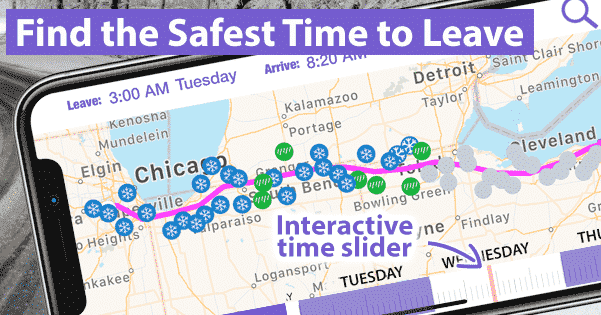Tips For Driving Safe In Bad Weather

Driving safe in bad weather is extremely important. Whether you drive in bad weather conditions as a daily occurrence or an infrequent event following these 9 safety tips for driving in bad weather can help you arrive at your destination safely.
9 Tips for Driving in Bad Weather Conditions:
1. If Possible, Avoid Driving in The Worst Weather Conditions
Driving in hazardous weather conditions in not safe. Unless there is an important reason why you need to drive during that blizzard, torrential down pour, extreme cold or foggy conditions, then stay safe at home until the weather conditions improve. If you don’t have to then why take the risk of injuring yourself by driving in unsafe weather conditions.
2. Check Your Tire Treads
Tires with worn treads have difficult time gripping the road in wet, snowy, or icy conditions. Tires should be rotated regularly for even tread wear. When you have your tires rotated ask the mechanic to check the tread and let you know if they are starting to wear down.
3. Wear Your Seat Belt
Wearing a seat belt is the law in the United States and Canada. Wearing a seat belt can save your life in the event of an accident. The chances of an accident increase during poor weather conditions. Therefore, it is especially important to wear a seat belt when driving in bad weather.
4. Leave Extra Travel Time When Driving in Poor Weather
Whether you are driving a mile from home or traveling across country bad weather will slow you down. Under these circumstances make sure to plan your trip so that you leave extra travel time to ensure that you slow down and arrive safely. In extreme cases you may even need to pull over if road or weather conditions get too bad.
5. Put Extra Distance Between Your Car and The Car in Front of You
Driving in bad weather with worsening road conditions it can make stopping your car more difficult which will require more time and distance. Experts recommend that you keep at least 9 seconds behind the car in front of you when the weather is bad.
6. Slow Down Before A Curve or Making A Turn
Approaching a turn or a curve too fast is always dangerous. However, when the roads are wet or slippery it is even easier to lose control of your car. Slowing down before the curve and coasting around it, accelerating slighting as you finish the turn will help you maintain better control around the curve and prevent slipping or sliding and losing control.
7. Be Extra Careful Crossing Bridges and Overpasses
Whether the roads are wet from rain or you are driving in cold weather, use extra care when driving across bridges and overpasses. In the winter bridges and overpasses tend to freeze faster and stay icy longer causing hazardous driving conditions. Approach these bits of the route with extra caution.
8. If You Are Planning A Long Trip Plan the Safest Route
If you are planning a long trip and know the route will include bad weather, then take the time to plan the safest route. Look for a route that is well traveled with the straight roads that are in good condition and well maintained by the Department of Transportation.
9. Download the Drive Weather App and Check the Weather All Along Your Route
The Drive Weather App can really help you travel more safely. It will provide you with accurate weather conditions at various points along your driving route. The Drive Weather App will also allow you to update your weather forecast when your departure time changes. This way you will always know the latest weather conditions and can plan your trip according to the most recent weather information.






